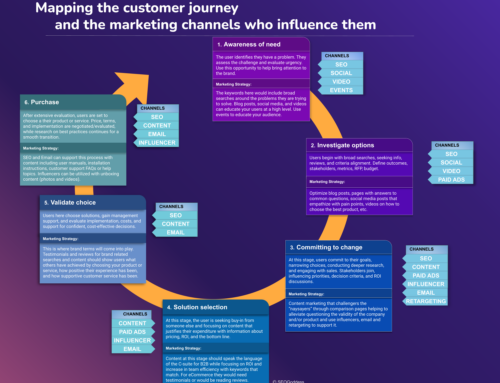As you probably know by now, the key to creating a successful blog or website is through implementing SEO tactics. By effectively applying these SEO tips, you can boost the ranking of your webpage, increase readership, maximize authentic traffic, and greatly increase the credibility and success of your webpage.
1) Develop a niche. Having a site with an incredibly broad focus will make it more difficult to attract and build an audience. Instead, choose a core focus and become an expert on it.
2) Write more content. Ample content is key to SEO, and the more content you have, the higher your page will rank. Keep the content relevant, unique, and of top quality, as this will create a sense of credibility and authority within your niche.
3) Regularly post new content. Sites that are outdated or haven’t been updated in a while will often rank lower than those that are updated frequently. Get on a schedule and set goals to constantly produce at least one to three new pieces of new content per week. The more you post, the more your site will benefit.
4) Never post duplicate content. This is one of the most important SEO tips you can implement. Even if you wrote the original, posting content that has been previously published elsewhere on the web will result in harsh penalties from search engines.
5) Create unique content. The more unique the content, the more likely it is to drive authentic users to the site. The Internet is overloaded with information on practically every available subject. By writing about less common topics or providing a new and unique perspective on a topic, you can set yourself apart from the competition.
6) Never compromise quality for quantity. While quantity is an important factor in SEO, having an abundance of poorly written or generic material will only hinder your ranking. If you have to choose between quantity and quality, quality should always come first.
7) Ensure each page is content-rich. It is better to have a few pages with lots of content, than to have a lot of pages with little content.
8) Continuously update your pages. Pages that have become dormant are more likely to be buried in search results.
9) Always use a plagiarism checker. Even if you are writing the content yourself, it is good to put it through a plagiarism checker to ensure it isn’t too similar to another webpage. Anything that appears to be copied content will result in a sharp penalty from Google.
10) Utilize keywords and phrases appropriately, but do not overuse them. Keyword density should be around 2-5% of the article.
11) Include your primary keyword phrase in the domain name. This is essential to creating the base of your traffic. If you have a company offering landscaping services in Washington, the words ‘Washington’ and ‘landscaping’ should appear in the domain name.
12) Focus on one or two keyword phrases throughout each piece of content. Confining your keyword focus will better enable search engines to appropriately categorize your content.
13) Ensure that every page on your site has a keyword rich title tag. This is essential to SEO, as the title is the first place that the spiders will crawl.
14) Over 40% of all computer searches consist of 4 or more words. Thus, incorporating relevant long-tail keywords in your content is essential.
15) Keyword phrases should be popular but not too popular. The more heavily searched a keyword phrase is, the more competition you will have for it. By choosing unique but relevant keywords, you can minimize competition and maximize traffic.
16) Focus on longer keywords rather than shorter ones. For instance, if you have a site about biking, the word ‘biking’ will not be an effective primary keyword in itself, as it will have far too much competition to be useful. Rather, come up with relevant long-tail keyword phrases like ‘best mountain biking trails’ or ‘hardcore BMX biking.’
17) Titles should always be written with keywords in mind rather than for the sake of cleverness. For example, if you are writing an article intended to convince people to take up surfing, a title such as “5 Reasons to Take Up Surfing Now,” will be more effective than “The Thrill of the Wave.”
18) Make a list of numerous keywords, and dedicate one page of your site to each keyword. This will make your pages easier to categorize by search engines.
19) Study the competition. Research the sites of high-ranking competitors to identify their method, approach, and keyword usage.
20) Create a Meta Description for every page. The Meta Description should be engaging and rich in keywords. This is ultimately how you will convince the reader to come to your site.
21) Include relevant links throughout your text. It is important to link primary keywords within the text and link to other high-ranking sites.
22) Don’t overuse links. In the same way that overusing keywords can come across as spam, overusing links will produce the same effect.
23) Never purchase links. While it can be tempting to purchase links as a quick way to boost traffic, by doing so you will actually do more harm than good. Search engines have ways of identifying purchased links and will penalize sites for using them.
24) Links to .edu websites often hold the most clout. In general, the higher the quality of the site you are linking to, the better your chances of increasing in page rank.
25) It is okay to ask for backlinks. If you find other sites of similar niche, consider building a rapport with the site and asking for a link. However, do so respectfully and avoid coming across as pushy.
26) Give as much as you take. Don’t expect others to backlink to you if you are unwilling to backlink to them. The Internet is a community and people are more likely to link to you if the favor is reciprocal.
27) The better the site, the better the backlink. Try to get sites of a similar niche, high-ranking sites, and sites with .edu or .gov in the domain name to backlink to your site. This can be achieved by creating top quality content that the site would be inclined to link to, by being an active member of the community on their site, and by linking to their site throughout your own articles.
28) Get to know other bloggers within a similar niche. The better rapport you form with such bloggers, the more likely they are to link to you.
29) Find out who is linking to your competition. If certain sites seem apt to linking to other similar sites, than chances are they will link to your site as well. You simply need to build a presence and let them know you are there.
30) Offer to contribute to other sites of similar niches. People are more likely to link to your site if you play an active role in theirs. Also, it is yet another way to get your name out there.
31) All images should be complete with captions that are rich with keywords. This will make them easier to find in search results.
32) Be sure to incorporate the words ‘image’ and ‘picture’ into the caption of every photo, as these two words are heavily searched for with other keywords.
33) Get active in social media. By gaining a presence on sites like Twitter, Facebook, Digg, and StumbleUpon, you can greatly increase the ranking and traffic of your site.
34) Avoid JavaScript if possible. While webpages in JavaScript are flashy and aesthetically appealing, they are not easily readable by search engines. This will result in poor SEO and a decline in traffic.
35) If you decide you have to use Java Script, be sure to incorporate text links into the page so that the spiders have a way to navigate the site.
36) Get Google Analytics. Google Analytics will provide you with SEO tips that will help you better determine exactly what people are searching for and which pages they spend the most time on. This will enable you to customize your content in a way that will better optimize traffic results.
37) Be patient. No website will go viral overnight. If your site is still new, it may take a while to gain a good ranking and readership. As you continue to produce great content, your audience will continue to grow.
38) Always be ready to adapt. Search engines periodically adjust their algorithms, which can often result in a sharp decline in traffic if you are unprepared. Constantly stay up to date on all potential algorithm changes, so you can adjust your strategy as needed.
39) Beware of Google penalties. Google will penalize your site for a variety of reasons. If a site incorporates spam, overusing keywords, link baiting, or other black hat techniques, Google may permanently penalize your site. Always blog ethically to avoid being penalized, as a single penalty could result in a permanent decline in traffic.
40) Engage your reader. Having a successful webpage is less about the quantity of traffic and more about the quality of traffic. If thousands are driven to your page but only glance at it for a second or two, this is of little use to you. The more you can engage the reader, the longer they will stay on your page, creating more high-quality traffic for you.
41) Link your content to your Google+ account. This will enable you to share it will your Google followers, while increasing credibility with search engines.
42) Add videos to your site. This will encourage traffic to spend more time on each page. Be sure to complement the video with ample text, as that is necessary to bring the traffic in.
43) Once you have created a video for your site, post the video to numerous locations, all of which can link back to your site. Sites like YouTube, MetaCafe, MSN, and Yahoo are all great places to post videos.
44) Widen your scope. Providing a diverse array of content and media sources will broaden the potential demographic you engage. Use multiple forms of media like pictures, videos, blog posts, news articles, podcasts, and forum boards to provide entertaining content to a wide array of people.
45) Build your site so that it is easy to navigate. This will encourage readers to spend more time on it. Sites with high aesthetic appeal, easy and informative reading, and a logical layout will be more alluring to your audience.
46) Periodically check your links to ensure they still work. Sometimes a site you are linking to may become inactive, resulting in a faulty link. Ensure all your links are up-to-date so your page will continue to rank.
47) For businesses, encourage your CEO to blog as well. This will increase credibility and further engage your audience. Having a live Q&A forum hosted by the CEO is a great way to drive traffic to your site.
48) Be sure to add a sharing feature to each page that will allow visitors to share your links easily on social media sites.
49) Enable comments on each page to encourage discussion, and invite the community to get involved. Doing so will also increase the content on a given page, thereby encouraging a higher ranking.
50) Invite guest bloggers to post on your site to broaden your scope. Doing so will heighten your chances of receiving backlinks and being asked to guest blog on other sites.
The Story of the SavetheBreakfastSandwich.com Website
The Starbucks Breakfast Sandwich In January of 2008, I was gainfully employed with one of the many technology corporations based in Redmond, WA (No it wasn't Microsoft). It was Concur Technologies, [...]
SEO Checklist – Focusing on Social Media
As some of you know I teach a beginner to advanced SEO Workshop. One of the most asked for items in my talk is the SEO Checklist I have developed just [...]
Building a Social Media Community
The staff at Jenn Mathews Consulting use a system for social media marketing called the A.L.I.V.E. system. A majority of our clients have created their Facebook page and Twitter account, but [...]











